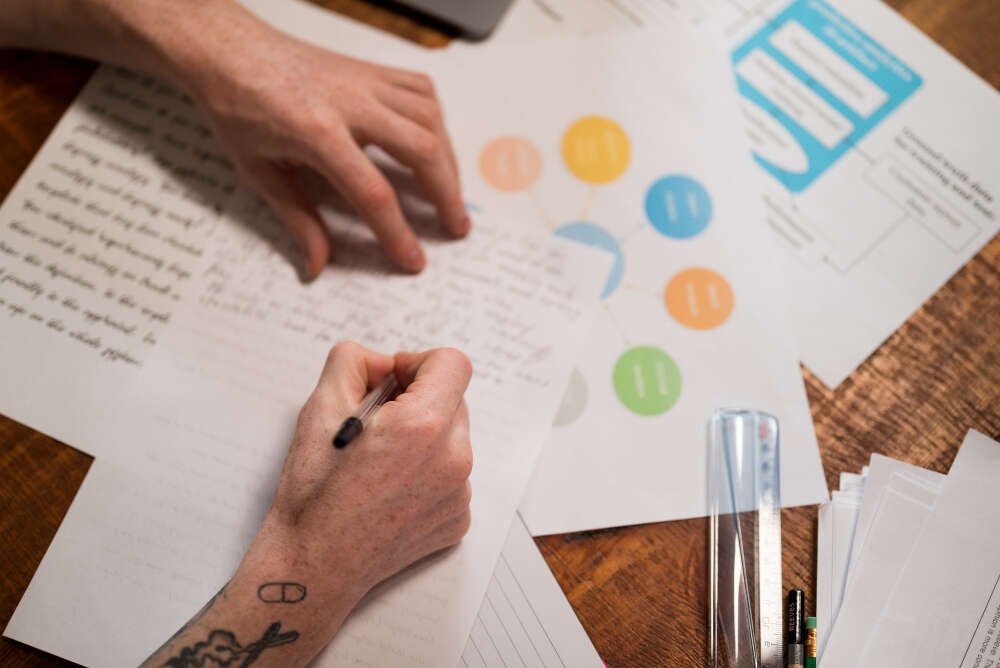
Table of Contents
It is crucial to understand how to write a research proposal as a student, scholar, or a professional researcher. A research proposal is not just a preliminary document as it contains all the information about the research process. It defines the issues you propose to solve, the research questions you have and the strategy you want to employ, and the relevance of the study. Regardless of whether it is prepared for a thesis, dissertation, journal, or grant application, a good prepared proposal helped to show that the writer is ready to work, think critically and asked of properly.
With this guide on the research proposal in 2025, you will learn the different easy steps in proposing your research proposal as well as how to format the same like a professional. It includes general differentiations like qualitative research versus quantitative research, how to write a literature review as well as objectives and method section.
At the end of this series, you would be able to have expert tips on how to go about your writing, a step by step guide, sample of how it should be formatted and the specific samples which you can download for use. This guide is useful for students who are writing their first academic proposal or for those who want to enhance their proposal writing skills in general.
What is a Research Proposal?
A research proposal is more of the contracting plan of a proposed research and is distinctly written to set out major features of a proposed research. It consists of research question or question for study, background to the study, aims or objectives, methodological framework and predicted results. Its main aim is to convince the reviewers, whether it is the academic advisers, the funding bodies or institutional committees that your research idea is viable, important and well thought through. This blog aims at capturing an understanding of the concept of a research proposal as important in the preparation of thesis/dissertation among graduate students as well as
when conducting academic research to secure grants among other instances like large scale investigations. It is a tool of communication that shows that you understand the topic and the approaches that can be used to study it. It is important to understand the format of the research proposal. The majority of proposals are organised into sections: introduction, literature review, research design, time frame, and references. All of them are aimed at explaining how the study will be conducted and why it is important.
In the process of conducting research, the proposal stage comes after the idea generation but before the data collection phase. It is a guide to action and can be revised and adjusted. A good research proposal not only gets approval but also gives a clear vision, focus and framework to the whole research process.

Why Writing a Research Proposal Matters in 2025
In 2025, it is crucial to know how to write a research proposal to be able to complete the task successfully. As more and more scholars pay attention to your research area and as technology advances, a good proposal is your key to academic endorsement, funding, and publication.
In the academic context the proposal plays role in the preparation of thesis and dissertation. They need them to determine the practicality, novelty, and scholarly relevance of a student’s work. In the case of professionals, especially those seeking grants or institutional funding, a research proposal is usually a requirement that defines the feasibility of the project.
Writing a proposal also assists in defining the research area of interest. It makes you to set specific goals and objectives, choose the right approach and bring your work into line with the existing literature. This is especially important in the current world where there is a lot of information available but what is relevant and accurate is what matters.
The expectations in 2025 have evolved. Nowadays, institutions expect more creativity, better ethical aspects, and sometimes the integration of plagiarism detection or AI-based research mapping. It is important to know how to meet these criteria as it is a competitive advantage. In the long run, a good proposal enhances your reputation as a researcher. It demonstrates that you are not only interested but you are organised, professional, and eager to advance knowledge in a significant manner.
Step-by-Step Guide: How to Write a Research Proposal

Step 1 – Title Page and Abstract
The title page is the first thing reviewers see and sets the tone for your proposal. It should include your research title, your name, institution, department, and submission date. Keep the title specific, clear, and informative—avoid vague or overly broad phrases.
An effective abstract follows the title page and provides a summary of your proposal. Typically 150–250 words, the abstract should briefly state the research question, objectives, methodology, and anticipated results. Write in a clear, formal tone without jargon, ensuring the reader immediately understands what the project is about.
Tone Tip: Use third person and past/future tense (“This research will investigate…”).
Example Title:
“Exploring the Impact of Remote Work on Employee Productivity in Tech Startups: A Mixed-Methods Study”
A well-formatted title page and abstract reflect professionalism and offer a concise snapshot of your proposal. Avoid filler content, and revise for clarity and coherence. Since many reviewers decide whether to continue reading based on the abstract alone, make every word count.
Step 2 – Introduction and Background
The introduction is your opportunity to hook the reader and justify why your study matters. Start with a compelling fact, statistic, or real-world example related to your topic. Then, gradually narrow your focus to the specific research problem.
Clearly state the problem your study will address, outlining why it’s important in your field. Explain any gaps in current knowledge and how your research will fill them. The background section should also briefly touch on key concepts, setting the stage for your methodology.
A well-written introduction balances brevity with clarity and includes brief references to existing literature. For example, you might reference 2–3 landmark studies to demonstrate your understanding of the field without overwhelming the reader.
End this section with a sentence or two that sets up your research objectives, serving as a transition to the literature review. The introduction and background provide essential context and convince the reviewer that your project is timely, feasible, and meaningful.
Step 3 – Literature Review
The literature review is where you show you’ve done your homework. It involves critically analyzing existing studies related to your research topic, identifying key gaps, trends, and scholarly debates. Your goal isn’t just to summarize but to synthesize—how does your study build on or diverge from existing knowledge?
Start by grouping your sources thematically or chronologically. Focus on studies that are recent, relevant, and peer-reviewed. Use sources from academic journals, books, and official reports. Highlight contradictions or underexplored areas that justify your research.
Avoiding Plagiarism Tips:
- Always cite your sources, even when paraphrasing.
- Use reference management tools like Zotero or Mendeley.
- Write in your own words rather than copying phrases.
This section should lead naturally into your research questions. It justifies the need for your study and shows where it fits in the academic conversation. Make sure to maintain a neutral and analytical tone while referencing relevant theories and authors.
Step 4 – Research Questions/Objectives
This section outlines the core objectives of your research and the specific questions you plan to explore. The goals should be clear, focused, and achievable within your timeframe and resources.
Strong vs Weak Research Objectives:
Type | Strong Objective | Weak Objective |
Specific | “To assess the impact of online learning on student engagement in higher education.” | “To study online learning.” |
Measurable | “To compare pre- and post-test scores among two student groups.” | “To understand how students learn.” |
Aligned | “To evaluate the effectiveness of blended learning using survey data.” | “To explore learning environments.” |
Make sure each objective aligns logically with your chosen methods. If you’re conducting interviews, ensure your questions are qualitative in nature. If using surveys, design your objectives to be measurable and statistical.
Well-defined research questions guide your methodology and give your project direction. Poorly written ones can derail your entire proposal, so spend time crafting them carefully.
Step 5 – Research Methodology
The research methodology is the backbone of your proposal. This is where you define how you plan to conduct your study, including tools, techniques, sampling, and data analysis. First, clarify whether your approach is qualitative, quantitative, or mixed-methods, and explain why it best suits your objectives.
Then describe your data collection methods—surveys, interviews, experiments, etc.—and explain how you’ll ensure validity and reliability. Mention your target population, sampling method, and ethical considerations.
Table: Qualitative vs Quantitative Research
Method | Qualitative | Quantitative |
Focus | Understanding lived experiences | Measuring variables numerically |
Tools | Interviews, focus groups | Surveys, experiments |
Sample Size | Small, purpose-driven | Large, randomized |
Data | Non-numeric (themes, narratives) | Numeric (percentages, statistics) |
Understanding the qualitative vs quantitative divide ensures your methodology matches your research objectives. Avoid mixing methods without clear justification, and ensure your data analysis plan is logical and appropriate.
Step 6 – Timeline and Work Plan
The timeline and work plan section outlines how you’ll manage your research over a specific period. It demonstrates that your proposal is not only well-structured but also feasible within a given timeframe. Use a Gantt chart or a monthly breakdown to visualize milestones like literature review, data collection, analysis, and final report writing. Assign realistic time slots to each activity, factoring in delays like ethics approval or fieldwork scheduling.
For example:
Gantt chart Table: Research Proposal Work Plan
Week | Literature Review | Tool Design / Pilots | Data Collection | Data Analysis | Draft Writing | Final Editing |
Week 1 | ✅ | |||||
Week 2 | ✅ | ✅ | ||||
Week 3 | ✅ | ✅ | ||||
Week 4 | ✅ | |||||
Week 5 | ✅ | ✅ | ||||
Week 6 | ✅ | ✅ | ||||
Week 7 | ✅ | ✅ | ||||
Week 8 | ✅ |
This roadmap helps reviewers see that you’ve considered the logistical execution of your plan. Be sure to link key deliverables to your timeline and leave room for unexpected challenges. A solid timeline adds credibility and shows you’re prepared for real-world research demands.
Step 7 – Expected Outcomes and Contributions
This section communicates the value of your research—academically, professionally, and socially. What do you hope to discover, prove, or challenge? Will your findings address a critical gap, improve policy, or inform future studies?
Describe your expected outcomes clearly and realistically. Avoid overpromising. For instance, instead of saying “This research will revolutionize education,” say “This study will offer insights into student engagement in online classrooms.”
Tie these outcomes back to your original objectives. Explain how your findings could benefit your discipline or contribute to real-world decision-making. If applicable, discuss how your work could influence future policy, practice, or research.
Academic proposals should emphasize originality and relevance. In 2024, this also means considering how your research fits into global conversations and addresses pressing societal issues. This section is where you show that your research matters beyond the page.
Step 8 – References and Appendix
Properly citing your sources is non-negotiable. Use a consistent academic style—APA, MLA, or Chicago—as required by your institution or field. Ensure all in-text citations are matched with a full entry in your reference list.
Sample APA Citation:
Smith, J. A. (2021). Digital Learning and Academic Performance. Journal of Educational Research, 35(2), 122–140. https://doi.org/xx.xxx/yyyy
The appendix houses supplementary materials that don’t fit into the main body but are essential to your project. These might include:
- Survey or interview questionnaires
- Ethics approval documents
- Raw data samples
- Consent forms
Keep appendices organized and referenced clearly within the proposal (e.g., “See Appendix A for survey sample”). Remember, the references and appendix section demonstrate both academic rigor and transparency. They show that your research proposal format is thorough, credible, and ethically sound.

Common Mistakes to Avoid While Writing a Research Proposal
Even strong ideas can be derailed by avoidable errors. One common mistake is being too vague and your proposal should be specific and focused. Another is failing to justify your research methodology, which makes your study appear weak or unstructured. Ignoring required research proposal format guidelines can lead to rejection on technical grounds. Lastly, skipping editing or proofreading can result in grammar issues, inconsistencies, and unclear arguments. Avoiding these mistakes helps ensure your proposal is academically sound, clear, and professionally presented.
Final Checklist Before Submission
Use this final checklist to ensure your research proposal is complete and polished:
- Title and abstract are clear
- Research questions are focused
- Literature review is comprehensive
- Methodology is well-justified
- Ethical issues are addressed
- Timeline is realistic (see Gantt chart)
- Formatting follows required guidelines (APA/MLA/Chicago)
- No plagiarism (checked via software)
- Grammar and spelling are error-free
- References are correctly cited
- Appendices are organized and referenced
- PDF format or submission-ready document prepared
Checking these items before submission can significantly boost your proposal’s success rate.

Conclusion
Mastering how to write a research proposal is a critical academic milestone. Whether you’re seeking funding, completing a thesis, or preparing for publication, a well-structured proposal lays the groundwork for your research success. This guide has walked you through essential steps from formatting and methodology to common pitfalls and timelines. If you found this helpful, bookmark, share, or download the free template to make your proposal writing journey even smoother.
FAQs about Writing a Research Proposal
Q1: How long should it be?
Ans: Typically 1,500–2,500 words (varies by institution or funding body).
Q2: Can I reuse parts of previous research?
Ans: Yes, but clearly cite and contextualize prior work to avoid self-plagiarism.
Q3: Is there a universal format?
Ans: No. However, most follow a standard research proposal format: title, abstract, background, methods, and references.



